Mallows in the Malvaceae
The Malvaceae according to Wikipedia is estimated to contain 244 genera with 4225 known species worldwide. Well-known members of economic importance include okra, cotton, cacao and durian.
In the temperate British Isles we grow many ornamental varieties but also have 9 genera growing in the wild. Only 3 are truly native though. The rest are mainly escapes from introduced garden plants.
Sidalcea malviflora or Greek Mallow
One such an introduced species is Sidalcea malviflora or Greek Mallow.
A perennial herb found as a naturalized garden escape or throw-out on roadsides, waste ground and refuse tips.
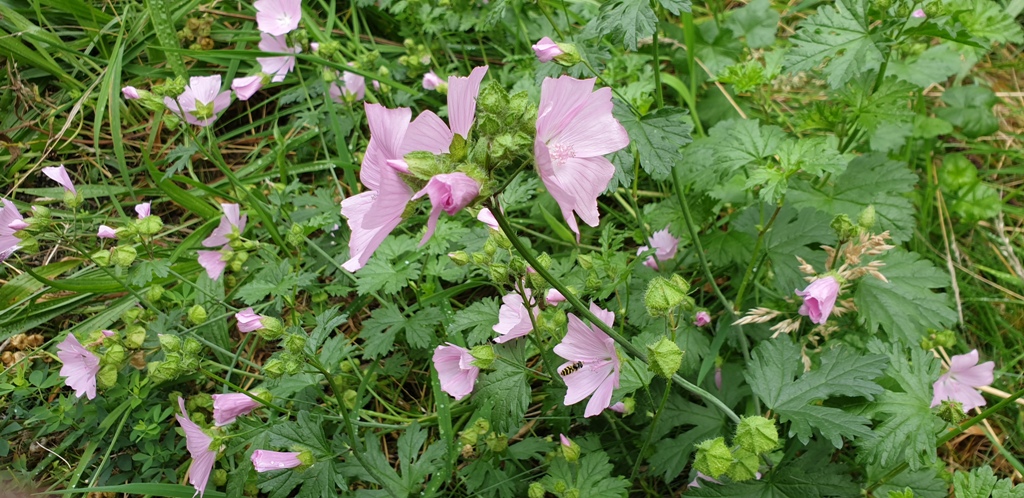
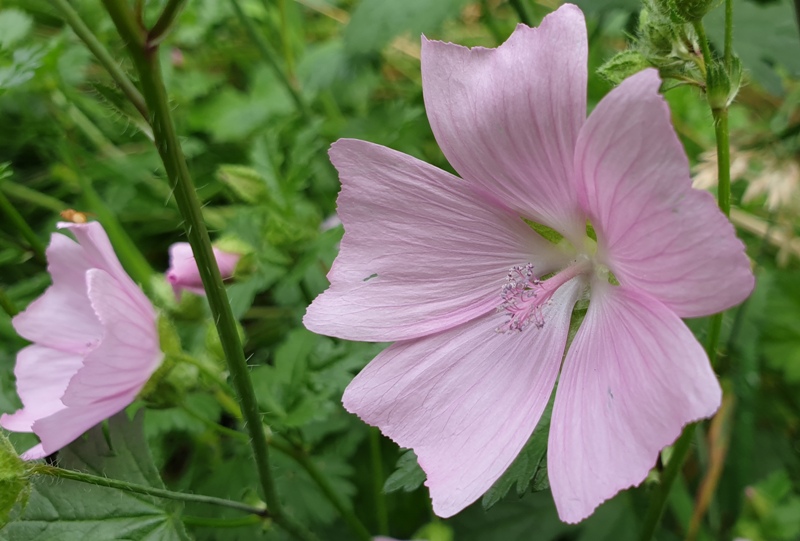
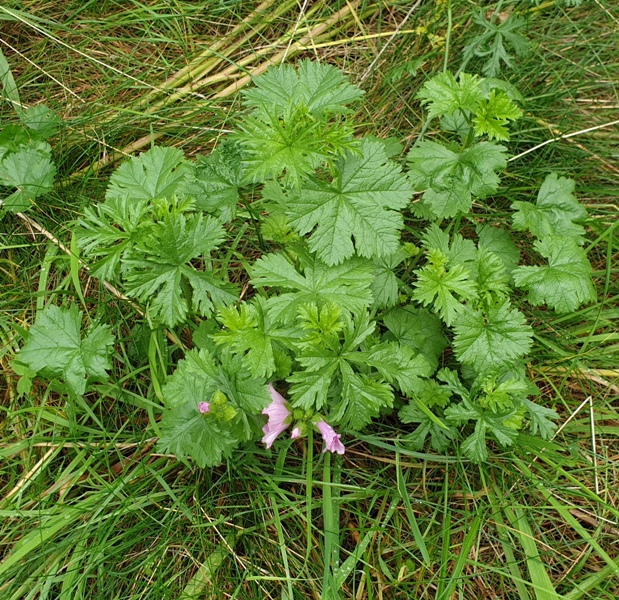
It is cultivated as an ornamental plant, for use in traditional, native plant, water conserving, and wildlife gardens. Thanks to Mike Poulton from Ecorecord for providing the pictures above.
Most of the Malvaceae are easy to recognise on their flowers with the stamens united into a tube round the carpels.
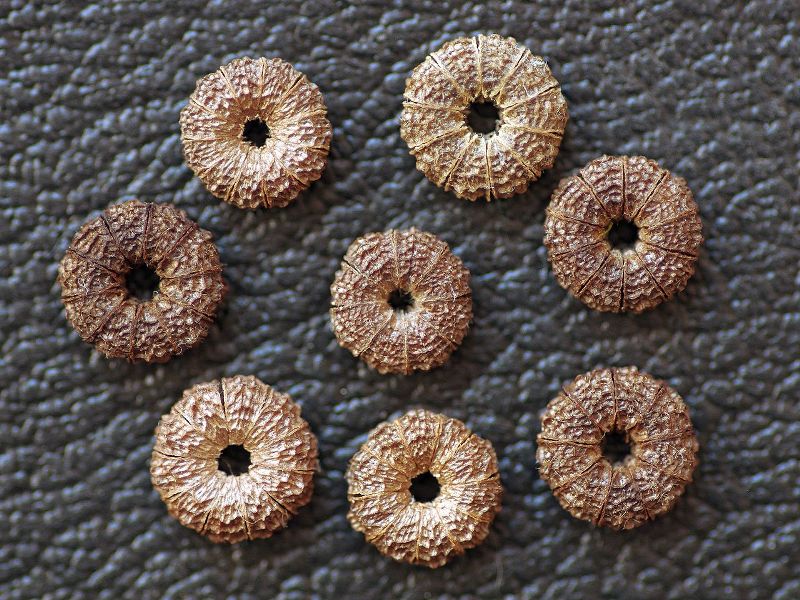
The fruits are also unique in that they look like miniature cheeses, those ones sold in a flat round box.
Malva is a genus with 5 native species and another 9 introduced/ ornamental species which all have similar, round, 5-petalled, ‘pink’ (light pink, magenta to maroon!) flowers. They also all have similar uses as to the species described below.
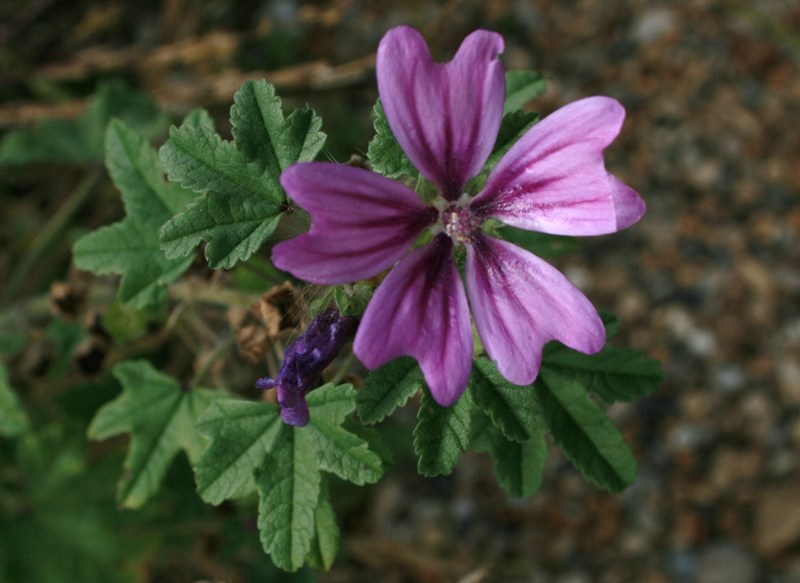
Malva sylvestris or Common Mallow.
As the name suggest this is the most common found Mallow.
An often partially winter-green drought-tolerant perennial herb, typically found in well-drained, often nutrient-enriched soils in unshaded situations, on roadsides, railway banks, waste ground and field-borders, often near settlements, around farms and in the shelter of walls, occasionally on sea-cliffs. It reproduces freely from seed.
It is an archaeophyte though according to Stace.
Malva sylvestris spreads itself on waste and rough ground, by roads and railways throughout lowland England, Wales and Channel Islands, Siberia and scattered elsewhere. It has been introduced to and has become naturalised in eastern Australia, in the United States, Canada, and Mexico as an invasive species.
The plant and flowers are pretty enough but there are also some cultivars such as ‘Zebrina’.
Leaves – raw or cooked
- The young leaves make a very acceptable substitute for lettuce in a salad.
- Mucilaginous with a mild pleasant flavour, they are nice in soups where they act as a thickener.
- The leaves are a tea substitute.
In Morocco, Tunisia and Palestine, Malva leaves are steamed with garlic and tomatoes, and eaten as an appetizer or salad. In Egypt, the leaves are made into a stew-like vegetable dish, especially in winter, known as khobeiza, which is similar to Molokheia.
Immature seed – raw.
- Used as a nibble, the seeds have a nice nutty flavour.
Flowers – raw.
- Added to salads or used as a garnish. A pleasant mild flavour, with a similar texture to the leaves.
Please note:
When grown on nitrogen rich soils (and particularly when these are cultivated inorganically), the plant tends to concentrate high levels of nitrates in its leaves. The leaves are perfectly wholesome at all other times.
Please note, this is an educational blog and we cannot take responsibility for any adverse effects for the medical use of plants. Always seek advice from a professional herbalist.
The leaves and flowers can be eaten as part of the diet, or a tea can be made from the leaves, flowers or roots. The leaves can be used fresh whenever they are available or can be harvested in the spring and dried for later use. The flowers are harvested in the summer and can be dried for later use.
- Externally, the leaves and flowers are the main part used, their demulcent properties making them valuable as a poultice for bruise, inflammations and to relieve insect bites and stings.
- Internally they are useful for respiratory system diseases and problems with the digestive tract. When combined with eucalyptus it makes a good remedy for coughs and other chest ailments. According to Julian Barker of the Med. Flora it is especially good for coughs and make a better expectorant than the Marshmallow
- The plant is an excellent laxative especially also for young children.
- Cream, yellow and green dyes can be obtained from the plant and the seed heads.
- A tincture of the flowers forms a very delicate test for alkalis.
- A fibre obtained from the stems is useful for cordage, textiles and paper making.
- The flowers were spread on doorways and woven into garlands or chaplets for celebrating May Day in the past.
- It is a dynamic accumulator and is used in Food forests.
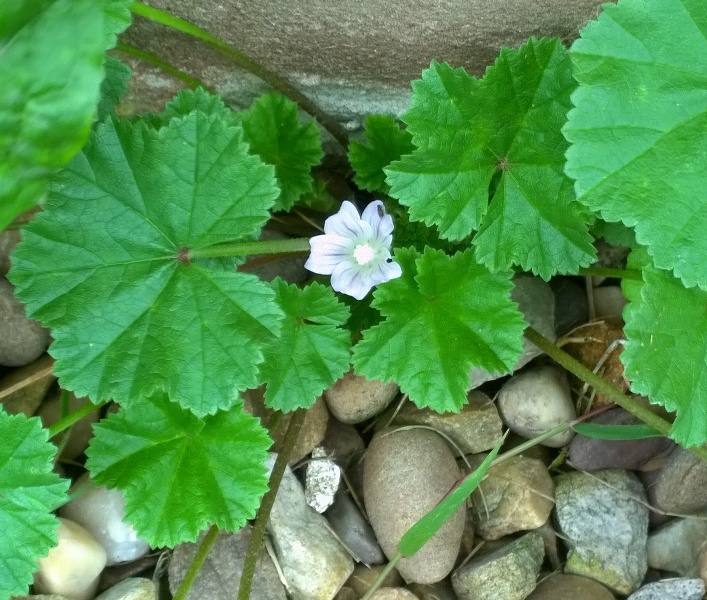
Malva neglecta or Dwarf Mallow
An annual herb, sometimes overwintering, found naturalized on paths and tracks, waste ground, arable headlands, gateways, rough ground and roadsides, often near human habitations, and occasionally on the drift-lines of beaches. It favours shallow, dry soils, and is tolerant of grazing, mowing and trampling, but not of competition with more vigorous species. It has a prostrate growing habit and half sized flowers from the above.
Uses are the same although Plants for a Future mentions one other edible use below:
- A decoction of the roots is used as an egg-white substitute for making meringue. The roots are brought to the boil in water and then simmered until the water becomes quite thick. This liquid can then be whisked in much the same way as egg whites.
Similar properties to other mallows, but are considered to be inferior to the marsh mallow (Althaea officinalis), though they are stronger acting than the common mallow (M. sylvestris). They are seldom used internally.
- A syrup can be made of this species for those who cannot get off to sleep (from Med. Flora)
At one time this plant was often cultivated for its edible leaves. Plants seem to be immune to the predations of rabbits. But prone to infestation by rust fungus.
- Cream, yellow and green dyes can be obtained from the plant and the seed heads.
- The root is used as a toothbrush.
- Dynamic accumulator.
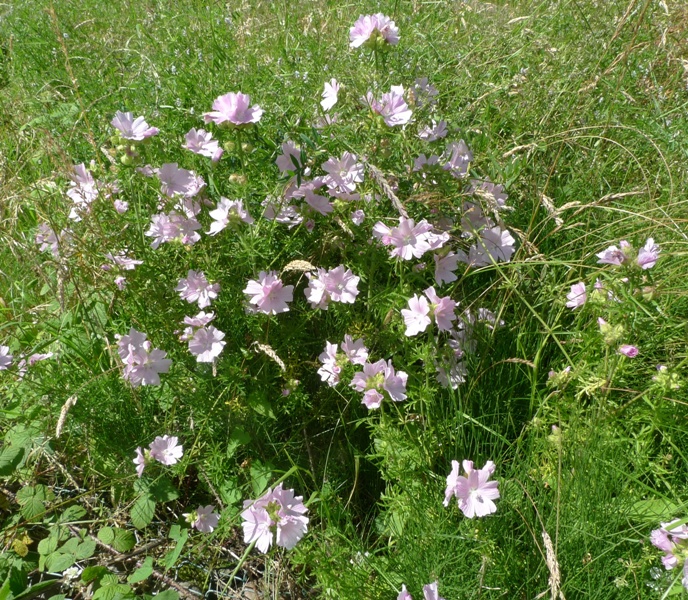
Malva moschata or Musk Mallow and here
A perennial herb of roadsides, hedgebanks, woodland edges, pastures, field-borders, riverbanks and grassy waste places, preferring well-drained soils in open or lightly shaded situations. It is tolerant of moderate levels of grazing or mowing, and seed is persistent in the soil.
This is widely grown as an ornamental perennial plant for its attractive scented flowers, produced for a long period through the summer. Several cultivars have been selected for variation in flower colour, including ‘Rosea’ with dark pink flowers. The cultivar ‘Alba’ (white flowered) has gained the Royal Horticultural Society‘s Award of Garden Merit.
Similar Uses to the other above species.
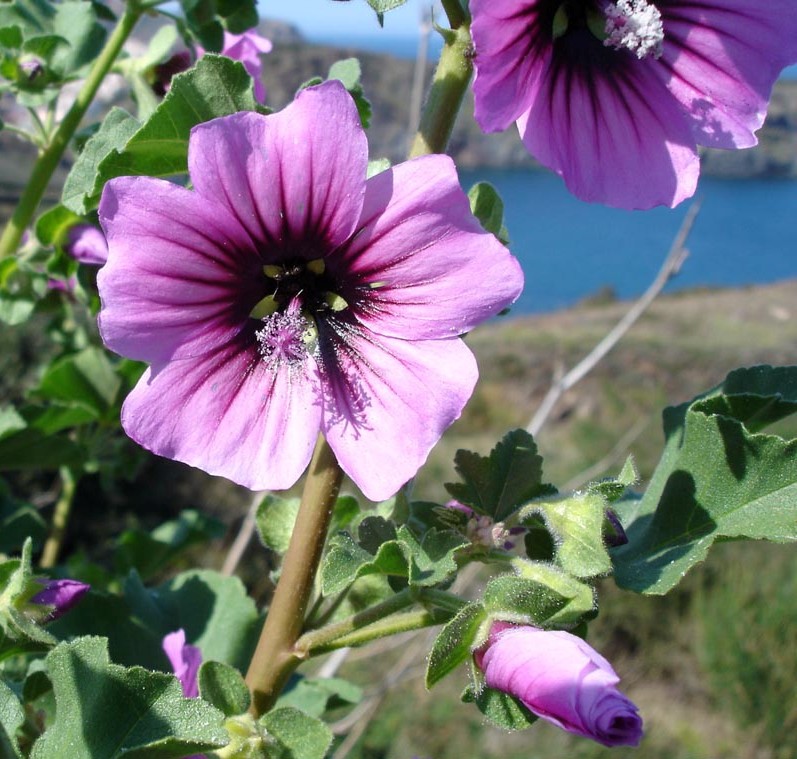
Malva arborea or Tree-mallow
This interesting, dwarf, tree like plant is a biennial to 3 metre tall, native along the coast.
A monocarpic herb, rarely native more than 100 m from the coast. It usually grows in shallow, nutrient-enriched soils, occurring most frequently amongst vegetation in seabird roosts, and on ground enriched by garden waste. Plants are killed by severe frost and the species is therefore restricted to mild micro-climates near the sea.
Malva arborea tolerates sea water to varying degrees, at up to 100% sea water in its natural habitat, excreting salt through glands on its leaves. This salt tolerance can be a competitive advantage over inland plant species in coastal areas. Its level of salinity tolerance is thought to be improved by soil with higher phosphate content, making guano enrichment particularly beneficial.
- The leaves are applied as a poultice to sprains. The flowers are soothing, like those of Marshmallow and not as laxative or antitussive as those of Malva sylvestris.
Other Uses:
It has an ornamental variegated leaf variety which I first saw at my friends’ nursery called Hillview Hardy Plants in Shropshire.
I found another brilliant webpage about this plant here
- It is thought to have been used as an alternative to toilet paper!
- The seeds are edible and are known in Jersey as “petit pains”, or “little breads”.
- Tree mallow was considered a nutritive animal food in Britain in the 19th century, and is still sometimes used as animal fodder in Europe.
Tree mallow seeds may be transported between separated coastal areas by the floating fruit, and seabirds are considered a likely means of spread. The seeds are encased in an impermeable outer case, and can remain viable for years, even after extended immersion in saltwater.
The tree mallow’s recent increased range among Scottish islands has raised concerns that it is displacing native vegetation, and is reducing Atlantic puffin (Fratercula arctica) populations in affected areas. The plant forms dense stands along the island coasts that inhibit breeding, and causes the puffins to abandon their burrows.
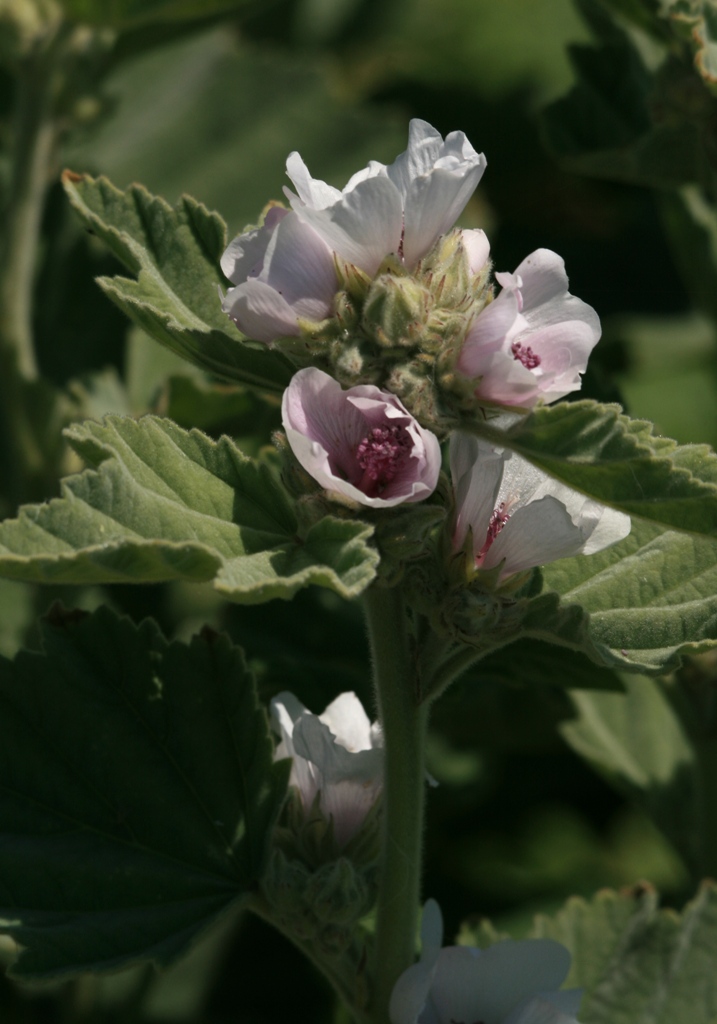
Althaea officinalis or Marshmallow
A perennial herb of coastal habitats, growing on the banks of ditches containing brackish water, in brackish pastures, and in the transition zone between the upper saltmarsh and freshwater habitats. It is intolerant of grazing and cutting.
The genus is distinguished from all the other mallows by the outer calyx having 6-9 lobes instead of the usual 3.
- Most of the mallows have been used as food, and are mentioned by early classic writers with this connection. Mallow was an edible vegetable among the Romans; a dish of marsh mallow was one of their delicacies.
- The flowers and young leaves can be eaten, and are often added to salads or are boiled and fried.
- The root extract (halawa extract) is sometimes used as flavouring in the making of a Middle Eastern snack called halva.
- The root can be used as a vegetable and it is also dried, ground into a powder, made into a paste and roasted to make the sweet ‘marshmallow’. The root contains about 37% starch, 11% mucilage, 11% pectin.
- The water left over from cooking any part of the plant can be used as an egg-white substitute in making meringues etc. It is concentrated by boiling until it has a similar consistency to egg white.
- A tea is made from the flowers. A tea can also be made from the root.
The commercial shop bought marshmallows, no longer contain real extracts of Althaea officinalis.
The leaves, flowers and the root of A. officinalis (marshmallow) have been used in traditional herbal medicine. This use is reflected in the name of the genus, which comes from the Greek ἄλθειν (althein), meaning “to heal.”
The leaves are harvested in August when the plant is just coming into flower and can be dried for later use.
Internal Uses:
- It is effective in treating inflammations and irritations of the mucous membranes such as the alimentary canal, the urinary and the respiratory organs.
- The root counters excess stomach acid, peptic ulceration and gastritis.
- The whole plant, but especially the root, is antitussive, demulcent, diuretic, highly emollient, slightly laxative and odontalgic.
- An infusion of the leaves is used to treat cystitis and frequent urination.
External Uses:
The root is best harvested in the autumn, preferably from 2 year old plants, and is dried for later use.
- Soothing to bruises, sprains, aching muscles, insect bites, skin inflammations, splinters etc.
- The root can be used in an ointment for treating boils and abscesses.
- The dried root is used as a toothbrush or is chewed by teething children. It has a mechanical affect on the gums whilst also helping to ease the pain.
- The root is also used as a cosmetic, helping to soften the skin.
- A fibre from the stem and roots is used in paper-making.
- The dried and powdered root has been used to bind the active ingredients when making pills for medicinal use.
- A glue can be made from the root. The root is boiled in water until a thick syrup is left in the pan, this syrup is used as a glue.
- An oil from the seed is used in making paints and varnishes.
- In food forests
